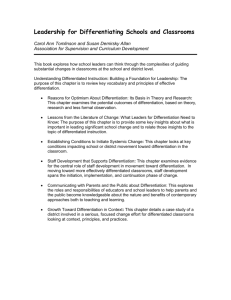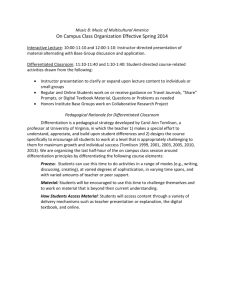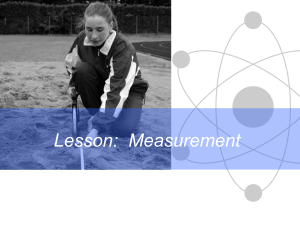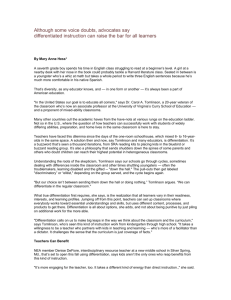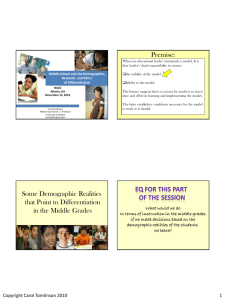File
advertisement
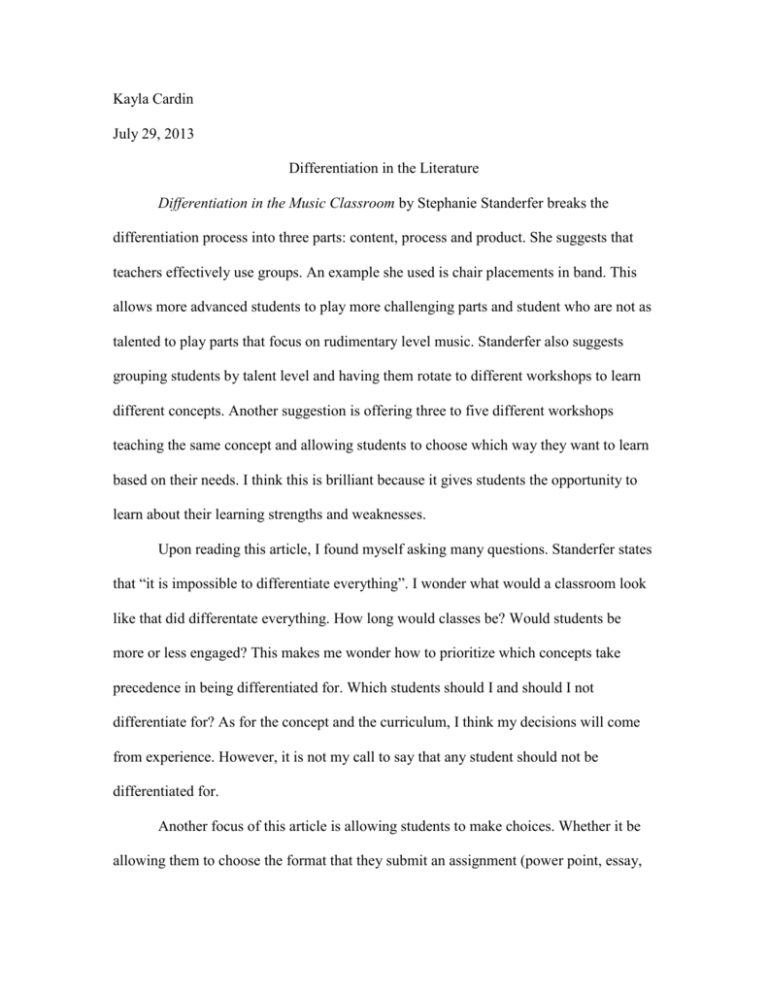
Kayla Cardin July 29, 2013 Differentiation in the Literature Differentiation in the Music Classroom by Stephanie Standerfer breaks the differentiation process into three parts: content, process and product. She suggests that teachers effectively use groups. An example she used is chair placements in band. This allows more advanced students to play more challenging parts and student who are not as talented to play parts that focus on rudimentary level music. Standerfer also suggests grouping students by talent level and having them rotate to different workshops to learn different concepts. Another suggestion is offering three to five different workshops teaching the same concept and allowing students to choose which way they want to learn based on their needs. I think this is brilliant because it gives students the opportunity to learn about their learning strengths and weaknesses. Upon reading this article, I found myself asking many questions. Standerfer states that “it is impossible to differentiate everything”. I wonder what would a classroom look like that did differentate everything. How long would classes be? Would students be more or less engaged? This makes me wonder how to prioritize which concepts take precedence in being differentiated for. Which students should I and should I not differentiate for? As for the concept and the curriculum, I think my decisions will come from experience. However, it is not my call to say that any student should not be differentiated for. Another focus of this article is allowing students to make choices. Whether it be allowing them to choose the format that they submit an assignment (power point, essay, presentation, etc) or allowing them to choose the function they take in an ensemble (melody, holding the steady beat, etc) students should have a say in what they learn. Students should also have a choice in using pop music in the classroom. If it helps them stay engaged and interested as well as allows them to relate different genres of music together…let it be! This is a perfect way to bridge Tomlinson’s concept of interest in a differentiated classroom. When students are able to bring their own passion for music into the classroom they seem to have an easier time connecting what they learn in class to what they listen to outside of school. Disregarding pop and rap music as non-examples creates an unnecessary gap between music in school and life-long musical skills. Allowing students to bring their prior knowledge of music into the classroom creates an environment of interest for each student. With all of this being said, how do standards relate to differentiation? Based on this article and the following article, there was no mention of standards. Are standards really important if they are not mentioned as the building blocks of our curriculum? This article seems to suggest that differentiated curriculum takes precedence over standards. As long as the students are discovering their learning styles as well as core concepts of music and music making, they should be fulfilling the state and national standards. In addition to standards, mastery is another concept that we learned about in our readings/class discussions that was not discussed in this article. Ideally, students should be able to master concepts if the material was differentiated properly for them. Based on the student’s needs, students should be able to challenge themselves by working towards mastering a new concept in every topic. Demystifying Differentiation for the Elementary Music Classroom by Erin Hillier offers four principles for teachers to begin to integrate differentiation into music classrooms. She suggests that teachers: focus on essential information before adding in enriching details, think of assessment and instruction as being linked, collaborate with their students to maximize learning, and encourage all students to participate in respectful work. Like the previously discussed article, Hillier offers many suggestions on how group work cannot only be incorporated into the music classroom but benefit the learners. Both articles offer suggestions about how to incorporate differentiation by using groups. Tomlinson also mentions the importance of splitting up classroom time between whole groups, small groups and individual learning. “The goal would be to have everyone work on not only on things they all need to do in common but also on things that were of particular importance for their own individual growth” (Tomlinson xviii). To me, this means that the class learns as a whole with all their strengths and weaknesses. This leads me to talk about equality and fairness in the classroom. With everyone having strengths and weaknesses, how can fairness and equality be achieved in a music classroom? As discussed in my postings for class, fair does not always have to be equal. Some students need more individual time that others. Other students need more time with directed instruction from a teacher. Some students work better learning kinesthetically while others learn visually or verbally. This is what makes differentiated classrooms such a special place, it is individualized to each student to maximize student learning. While reading the third principle, I had an “aha” moment. How can students collaborate in a musical ensemble that is teacher focused? Differentiation is a process that allows students to discover their own voice as a learner. How can they discover their voice when the teacher is solely running the classroom? How can we make the ensemble a more collaborative atmosphere? Hiller suggests that students have a say in the pieces that they play as well as choosing their own exercises and etudes from method books. That way, they can contribute to what they want to learn as well as what they need to learn. Another “aha” moment that occurred while I was reading was about assessment. Assessment is constantly happening from the teacher to the student. The teacher is continuously providing feedback for each student or each instrument section. This is excellent, but what if the teacher allowed more time for self and peer reflection? Selfreflection allows students to foster a sense of ownership of their learning. It allows them to think critically about their strengths and weaknesses as well as how to improve them. The challenge here is allowing students to learn and be challenged at their own pace. How far can we push each student to get better as a musician and student? “For the music teacher, the practice of differentiation leads to students who have higher selfefficacy, engagement and passion for making music”. (Hillier) Upon searching for articles, I found that there were not enough articles about differentiation in music classrooms. While searching for differentiation, I found a plethora of articles relating to math, business, accounting, etc. but few regarding differentiation in classrooms. It seems to me that differentiation is a relatively new field, especially in a music setting. Based on the few articles I skimmed in addition to the ones I read, I inferred that current teachers are scrambling to find new ways to apply differentiation in music classrooms. It seems that Tomlinson is number one when it comes to the philosophy of differentiation since every article I read seemed to mention her and her philosophies. Works Cited Hillier, Erin. (June 2011). Demystifying Differentiation for the Elementary Music Classroom. Music Educators Journal. Vol. 97 Issue 4, p49-53. 5p Standerfer, Stephanie. (June 2011). Differentiation in the Music Classroom. Music Educators Journal. Vol. 97 Issue 4, p43-47. 5p

